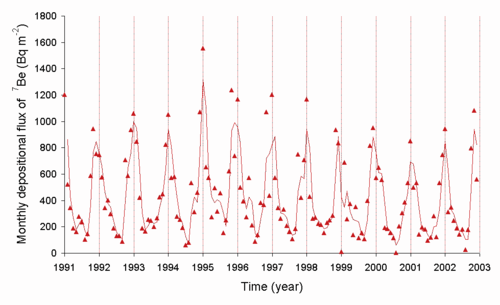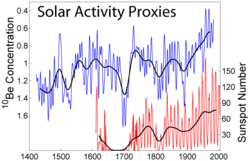Isotopes of beryllium
This article needs additional citations for verification. (May 2018) |
| |||||||||||||||||||||||||||||||
| Standard atomic weight Ar°(Be) | |||||||||||||||||||||||||||||||
|---|---|---|---|---|---|---|---|---|---|---|---|---|---|---|---|---|---|---|---|---|---|---|---|---|---|---|---|---|---|---|---|
Beryllium (4Be) has 11 known isotopes and 3 known isomers, but only one of these isotopes (9
Be) is stable and a primordial nuclide. As such, beryllium is considered a monoisotopic element. It is also a mononuclidic element, because its other isotopes have such short half-lives that none are primordial and their abundance is very low. Beryllium is unique as being the only monoisotopic element with an even number of protons (even atomic number) and also has an odd number of neutrons;[2] the 25 other monoisotopic elements all have odd numbers of protons (odd atomic number), and even of neutrons, so the total mass number is still odd.
Of the 10 radioisotopes of beryllium, the most stable are 10
Be with a half-life of 1.387 million years and 7
Be with a half-life of 53.22 days. All other radioisotopes have half-lives under 15 s, most under 30 milliseconds.
The 1:1 neutron–proton ratio seen in stable isotopes of many light elements (up to oxygen, and in elements with even atomic number up to calcium) is prevented in beryllium by the extreme instability of 8
Be toward splitting into two 4
He nuclei, which may be seen either alpha decay or a type of fission; in any case the half-life is only 8.2×10−17 s, short enough to normally be considered unbound. This, as with the relative instability of all lithium, beryllium, and boron isotopes, is favored due to the extremely tight binding of the helium-4 nucleus.
Beryllium is prevented from having a stable isotope with 4 protons and 6 neutrons by the very lopsided neutron–proton ratio for such a light element. Nevertheless, this isotope, beryllium-10, has a half-life above a million years and a decay energy less than 1 MeV, which indicates unusual stability given that condition.
Most beryllium present in the universe is thought to be formed by cosmic ray nucleosynthesis from cosmic ray spallation in the period between the Big Bang and the formation of the Solar System. The isotopes 7
Be and 10
Be are both cosmogenic nuclides because they are made, in the Solar System, continually at the rate they decay by spallation,[4] as is carbon-14.
List of isotopes
[edit]| Nuclide [n 2] |
Z | N | Isotopic mass (Da)[5] [n 3][n 4] |
Half-life[1] [resonance width] |
Decay mode[1] [n 5] |
Daughter isotope [n 6] |
Spin and parity[1] [n 7] |
Isotopic abundance | |||||||||||
|---|---|---|---|---|---|---|---|---|---|---|---|---|---|---|---|---|---|---|---|
| Excitation energy | |||||||||||||||||||
| 6 Be[n 8] |
4 | 2 | 6.019726(6) | 5.0(3) zs [91.6(5.6) keV] |
2p | 4 He |
0+ | ||||||||||||
| 7 Be[n 9] |
4 | 3 | 7.01692871(8) | 53.22(6) d | ε | 7 Li |
3/2− | Trace[n 10] | |||||||||||
| 8 Be[n 11] |
4 | 4 | 8.00530510(4) | 81.9(3.7) as [5.58(25) eV] |
α[n 1] | 4 He |
0+ | ||||||||||||
| 8m Be |
16626(3) keV | α | 4 He |
2+ | |||||||||||||||
| 9 Be |
4 | 5 | 9.01218306(8) | Stable | 3/2− | 1 | |||||||||||||
| 9m Be |
14390.3(1.7) keV | 1.25(10) as [367(30) eV] |
3/2− | ||||||||||||||||
| 10 Be |
4 | 6 | 10.01353469(9) | 1.387(12)×106 y[nb 1] | β− | 10 B |
0+ | Trace[n 10] | |||||||||||
| 11 Be[n 12] |
4 | 7 | 11.02166108(26) | 13.76(7) s | β− (96.7(1)%) | 11 B |
1/2+ | ||||||||||||
| β−α (3.3(1)%) | 7 Li | ||||||||||||||||||
| β−p (0.0013(3)%) | 10 Be | ||||||||||||||||||
| 11m Be |
21158(20) keV | 0.93(13) zs [500(75) keV] |
IT ? | 11 Be |
3/2− | ||||||||||||||
| 12 Be |
4 | 8 | 12.0269221(20) | 21.46(5) ms | β− (99.50(3)%) | 12 B |
0+ | ||||||||||||
| β−n (0.50(3)%) | 11 B | ||||||||||||||||||
| 12m Be |
2251(1) keV | 233(7) ns | IT | 12 Be |
0+ | ||||||||||||||
| 13 Be |
4 | 9 | 13.036135(11) | 1.0(7) zs | n ? | 12 Be |
(1/2−) | ||||||||||||
| 13m Be |
1500(50) keV | (5/2+) | |||||||||||||||||
| 14 Be[n 13] |
4 | 10 | 14.04289(14) | 4.53(27) ms | β−n (86(6)%) | 13 B |
0+ | ||||||||||||
| β− (> 9.0(6.3)%) | 14 B | ||||||||||||||||||
| β−2n (5(2)%) | 12 B | ||||||||||||||||||
| β−t (0.02(1)%) | 11 Be | ||||||||||||||||||
| β−α (< 0.004%) | 10 Li | ||||||||||||||||||
| 14m Be |
1520(150) keV | (2+) | |||||||||||||||||
| 15 Be |
4 | 11 | 15.05349(18) | 790(270) ys | n | 14 Be |
(5/2+) | ||||||||||||
| 16 Be |
4 | 12 | 16.06167(18) | 650(130) ys [0.73(18) MeV] |
2n | 14 Be |
0+ | ||||||||||||
| This table header & footer: | |||||||||||||||||||
- ^ a b Also can be considered spontaneous fission, as 8
Be splits into two equal 4
He nuclei - ^ mBe – Excited nuclear isomer.
- ^ ( ) – Uncertainty (1σ) is given in concise form in parentheses after the corresponding last digits.
- ^ # – Atomic mass marked #: value and uncertainty derived not from purely experimental data, but at least partly from trends from the Mass Surface (TMS).
- ^
Modes of decay:
EC: Electron capture
IT: Isomeric transition n: Neutron emission p: Proton emission - ^ Bold symbol as daughter – Daughter product is stable.
- ^ ( ) spin value – Indicates spin with weak assignment arguments.
- ^ Intermediate in the proton–proton chain (final step of PP I).
- ^ Produced in Big Bang nucleosynthesis, but not primordial, as it all quickly decayed to 7Li
- ^ a b cosmogenic nuclide
- ^ Intermediate product of triple alpha process in stellar nucleosynthesis
- ^ Has 1 halo neutron
- ^ Has 4 halo neutrons
Beryllium-7
[edit]Beryllium-7 is an isotope with a half-life of 53.22 days that is generated naturally as a cosmogenic nuclide.[4] The rate at which the short-lived 7
Be is transferred from the air to the ground is controlled in part by the weather. 7
Be decay in the Sun (the half-life in stars can be greatly different from the normal as it is a free rather than a bound electron that is captured) is one of the sources of solar neutrinos, and the first type ever detected using the Homestake experiment. Presence of 7
Be in sediments is often used to establish that they are fresh, i.e. less than about 3–4 months in age, or about two half-lives of 7
Be.[6]

Be from the air to the ground in Japan[6]
Beryllium-8
[edit]Beryllium-8 decays immediately into two alpha particles as its total energy is about 92 keV greater than that of the two alpha particles, and the Coulomb barrier to decay is negligible. This is unusual among light N = Z nuclides and creates a bottleneck in stellar nucleosynthesis, which requireds that a third alpha be immediately captured, known as the fusion of three alpha particles, to form stable carbon-12 and thence all heavier elements.
Beryllium-10
[edit]
Beryllium-10 has a half-life of 1.387×106 y, and beta decays to stable boron-10 with a maximum energy of 556.2 keV. It is formed in the Earth's atmosphere mainly by cosmic ray spallation on nitrogen and oxygen.[7][8][4] 10Be and its daughter product have been used to examine soil erosion, soil formation from regolith, the development of lateritic soils and the age of ice cores.[9] 10Be is a significant isotope used as a proxy data measure for cosmogenic nuclides to characterize solar and extra-solar attributes of the past from terrestrial samples.[10]
Decay chains
[edit]Isotopes of beryllium heavier than the stable 9Be decay via beta decay or a combination of beta decay and neutron emission. However, 8
Be splits in two to result in 4
He. Then, 7
Be decays only via electron capture, an exceptional occurrence in such a light element. For this reason, its half-life can be artificially lowered by 0.83% via endohedral enclosure (7Be@C60).[11] Finally even lighter isotopes decay exclusively by emitting protons and are also (like 8Be) unbound. The decay of all known beryllium isotopes is summarized as follows:
See also
[edit]Daughter products other than beryllium
Notes
[edit]- ^ Note that NUBASE2020 uses the tropical year to convert between years and other units of time, not the Gregorian year. The relationship between years and other time units in NUBASE2020 is as follows: 1 y = 365.2422 d = 31 556 926 s
References
[edit]- ^ a b c d Kondev, F. G.; Wang, M.; Huang, W. J.; Naimi, S.; Audi, G. (2021). "The NUBASE2020 evaluation of nuclear properties" (PDF). Chinese Physics C. 45 (3): 030001. doi:10.1088/1674-1137/abddae.
- ^ a b "Standard Atomic Weights: Beryllium". CIAAW. 2013.
- ^ Prohaska, Thomas; Irrgeher, Johanna; Benefield, Jacqueline; Böhlke, John K.; Chesson, Lesley A.; Coplen, Tyler B.; Ding, Tiping; Dunn, Philip J. H.; Gröning, Manfred; Holden, Norman E.; Meijer, Harro A. J. (2022-05-04). "Standard atomic weights of the elements 2021 (IUPAC Technical Report)". Pure and Applied Chemistry. doi:10.1515/pac-2019-0603. ISSN 1365-3075.
- ^ a b c S.V. Poluianov; G.A. Kovaltsov; A.L. Mishev; I.G. Usoskin (2016). "Production of cosmogenic isotopes 7Be, 10Be, 14C, 22Na, and 36Cl in the atmosphere: Altitudinal profiles of yield functions". J. Geophys. Res. Atmos. 121 (13): 8125–8136. arXiv:1606.05899. Bibcode:2016JGRD..121.8125P. doi:10.1002/2016JD025034. S2CID 119301845.
- ^ Wang, Meng; Huang, W.J.; Kondev, F.G.; Audi, G.; Naimi, S. (2021). "The AME 2020 atomic mass evaluation (II). Tables, graphs and references*". Chinese Physics C. 45 (3): 030003. doi:10.1088/1674-1137/abddaf.
- ^ a b Yamamoto, Masayoshi; Sakaguchi, Aya; Sasaki, Keiichi; Hirose, Katsumi; Igarashi, Yasuhito; Kim, Chang Kyu (January 2006). "Seasonal and spatial variation of atmospheric 210Pb and 7Be deposition: features of the Japan Sea side of Japan". Journal of Environmental Radioactivity. 86 (1): 110–131. doi:10.1016/j.jenvrad.2005.08.001. PMID 16181712.
- ^ G.A. Kovaltsov; I.G. Usoskin (2010). "A new 3D numerical model of cosmogenic nuclide 10Be production in the atmosphere". Earth Planet. Sci. Lett. 291 (1–4): 182–199. Bibcode:2010E&PSL.291..182K. doi:10.1016/j.epsl.2010.01.011.
- ^ J. Beer; K. McCracken; R. von Steiger (2012). Cosmogenic radionuclides: theory and applications in the terrestrial and space environments. Physics of Earth and Space Environments. Vol. 26. Physics of Earth and Space Environments, Springer, Berlin. doi:10.1007/978-3-642-14651-0. ISBN 978-3-642-14650-3. S2CID 55739885.
- ^ Balco, Greg; Shuster, David L. (2009). "26Al-10Be–21Ne burial dating" (PDF). Earth and Planetary Science Letters. 286 (3–4): 570–575. Bibcode:2009E&PSL.286..570B. doi:10.1016/j.epsl.2009.07.025. Archived from the original (PDF) on 2015-09-23. Retrieved 2012-12-10.
- ^ Paleari, Chiara I.; F. Mekhaldi; F. Adolphi; M. Christl; C. Vockenhuber; P. Gautschi; J. Beer; N. Brehm; T. Erhardt; H.-A. Synal; L. Wacker; F. Wilhelms; R. Muscheler (2022). "Cosmogenic radionuclides reveal an extreme solar particle storm near a solar minimum 9125 years BP". Nat. Commun. 13 (214): 214. Bibcode:2022NatCo..13..214P. doi:10.1038/s41467-021-27891-4. PMC 8752676. PMID 35017519.
- ^ Ohtsuki, T.; Yuki, H.; Muto, M.; Kasagi, J.; Ohno, K. (9 September 2004). "Enhanced Electron-Capture Decay Rate of 7Be Encapsulated in C60 Cages". Physical Review Letters. 93 (11): 112501. Bibcode:2004PhRvL..93k2501O. doi:10.1103/PhysRevLett.93.112501. PMID 15447332. Retrieved 23 February 2022.

![{\displaystyle {\begin{array}{l}{}\\{\ce {^{6}_{4}Be->[5\ {\ce {zs}}]{^{4}_{2}He}+{2_{1}^{1}H}}}\\{\ce {{^{7}_{4}Be}+e^{-}->[53.22\ {\ce {d}}]{^{7}_{3}Li}}}\\{\ce {^{8}_{4}Be->[81.9\ {\ce {as}}]{2_{2}^{4}He}}}\\{\ce {^{10}_{4}Be->[1.387\ {\ce {Ma}}]{^{10}_{5}B}+e^{-}}}\\{\ce {^{11}_{4}Be->[13.76\ {\ce {s}}]{^{11}_{5}B}+e^{-}}}\\{\ce {^{11}_{4}Be->[13.76\ {\ce {s}}]{^{7}_{3}Li}+{^{4}_{2}He}+e^{-}}}\\{\ce {^{12}_{4}Be->[21.46\ {\ce {ms}}]{^{12}_{5}B}+e^{-}}}\\{\ce {^{12}_{4}Be->[21.46\ {\ce {ms}}]{^{11}_{5}B}+{^{1}_{0}n}+e^{-}}}\\{\ce {^{13}_{4}Be->[1\ {\ce {zs}}]{^{12}_{4}Be}+{^{1}_{0}n}}}\\{\ce {^{14}_{4}Be->[4.53\ {\ce {ms}}]{^{13}_{5}B}+{^{1}_{0}n}+e^{-}}}\\{\ce {^{14}_{4}Be->[4.53\ {\ce {ms}}]{^{14}_{5}B}+e^{-}}}\\{\ce {^{14}_{4}Be->[4.53\ {\ce {ms}}]{^{12}_{5}B}+{2_{0}^{1}n}+e^{-}}}\\{\ce {^{15}_{4}Be->[790\ {\ce {ys}}]{^{14}_{4}Be}+{^{1}_{0}n}}}\\{}{\ce {^{16}_{4}Be->[650\ {\ce {ys}}]{^{14}_{4}Be}+{2_{0}^{1}n}}}\\{}\end{array}}}](https://wikimedia.org/api/rest_v1/media/math/render/svg/a497c0c3df361fb9d2c670e9871797b5a61b4615)